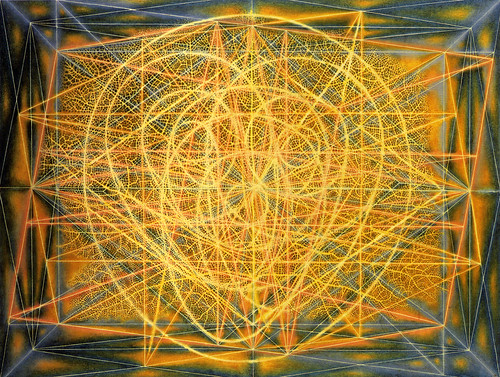DYSTOPIA!
The Work of Jeremy Geddes and Jean-Pierre Roy
The Work of Jeremy Geddes and Jean-Pierre Roy
But, before I go crazy with having too many things to say, I'm going to narrow in on color. These two painters are sensitive to color in a way I aspire to be. That is, sensitive to the smallest changes which are usually processed and disregarded by the subconscious. There is something overwhelmingly moral about being that attune to detail. But also the manipulation of color in these two painter's work are different. And those subtle differences contribute to the meaning of each. Which I will tell you about now.
Jean-Pierre Roy uses contrasts and mild juxtapositions to create a sense of discomfort in his paintings but without losing a basic sense of aesthetic complement. For example, to the left, the primary colors on the stadium make it seem fun and childish. The contrast between the gray organic forms surrounding the geometric stadium first appear like a mystical spectacle dividing form and color from confusion and binary. But looking closer, the smoking fires make clear a much stronger statement about the fine line between friendly competition and actual destruction.

Is that a Satre reference on the right? Dystopia wouldn't be complete without it huh? The clear contrast between the grey cityscape and the bright yellow hippie van seem to invert history and presence. In this meeting of two 60s symbols (hippie van and astronaut) on the empty, half-finished infrastructure of today, I feel closer to the van than anything else. Maybe its a statement about looking back before we continue moving forward, which wouldn't be unwise in my opinion.
There are several good astronaut paintings in this series. I like this one mainly because the pigeon seems to be pulling the figure up. To me these are about the excitement of space exploration which has now become mundane while the problems of our planet remain pressing, as presented in the littered broken down scenery. The ochre-tones in this one are warm throughout except the grey pigeon that you might almost not notice. In fact the first several times I looked at it I didn't even think about the pigeon. The painting is pointing out something that we take for granted, the little dirty things like pigeons in a city, that often permeate our daily lives.

This guy is sticking a fork in a toaster oven to light the halo on his head. Similar to the last one, I missed the halo the first few times I looked. The black that consumes the figure and paled skin tones here make the figure seem shallow and also mute the suggested presence of a halo. This painting was part of a more psychologically themed series, but I like it a lot since I understand too well some of the trouble you can run into when you become overly concerned with possibilities of divinity.
For more work:
Jeremy Geddes
Jean-Pierre Roy














